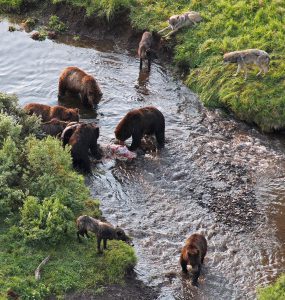Share this article
Wolves kill fewer ungulates with bears around
Wolves tend to kill prey less often when bears are present, according to recent research.
This is contrary to the previous assumption that wolves kill more often when bears are around because bears steal their food, according to Aimee Tallian, lead author of the study and recent graduate from Utah State University.

Hungry wolves wait to access their elk kill as brown bears feast on the spoils in Yellowstone National Park. ©Daniel Stahler, National Park Service
Tallian and her colleagues studied the relationship between the presence of brown bears (Ursus arctos) and the rate of wolf (Canis lupus) kills in Yellowstone National Park and in the Scandinavian Peninsula. Their findings were published in Proceedings of the Royal Society B. “The wolf projects in Yellowstone and Scandinavia have been collecting data on wolf predation for years, which allowed us to make a unique cross-system comparison,” Tallian said.
In both areas, large ungulates are the primary food source for wolves, which were recently reintroduced or recovered in both areas. But while the Scandinavian system has more anthropogenic factors such as forestry and logging, Yellowstone is less influences by human activity. The team wanted to determine if the effect of brown bears on wolf kill rate would be the same in both areas, despite these differences.
Tallian and her colleagues looked at long-term data collected in both systems regarding how often wolves killed ungulate prey, or wolf kill rate. They tracked the wolves and their kills using radio collars. In Yellowstone, the team looked for signs of brown bears at these kill sites. In Scandinavia, they were able to compare wolf kill rate in areas with and without bears.
What the team found surprised them: When bears were present, wolves killed ungulates less often. “We learn the most when we find answers that surprise us,” Tallian said. While the team plans to study the mechanisms behind this further, Tallian suspects there might be a few reasons for this. For example, she said wolves may not be abandoning their kills quickly, but waiting around longer to gain access to their food. She also suggests the wolves might be killing less frequently because it takes them longer to find prey.
Tallian also hopes to determine if this has any effect on the wolves’ fitness. “This is just the tip of the iceberg in terms of understanding how these two species interact,” she said.
Header Image: Tallian stands at a campsite in Yellowstone National Park’s Pelican Valley. ©Joel Ruprecht








